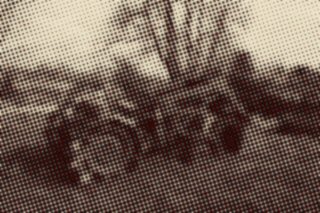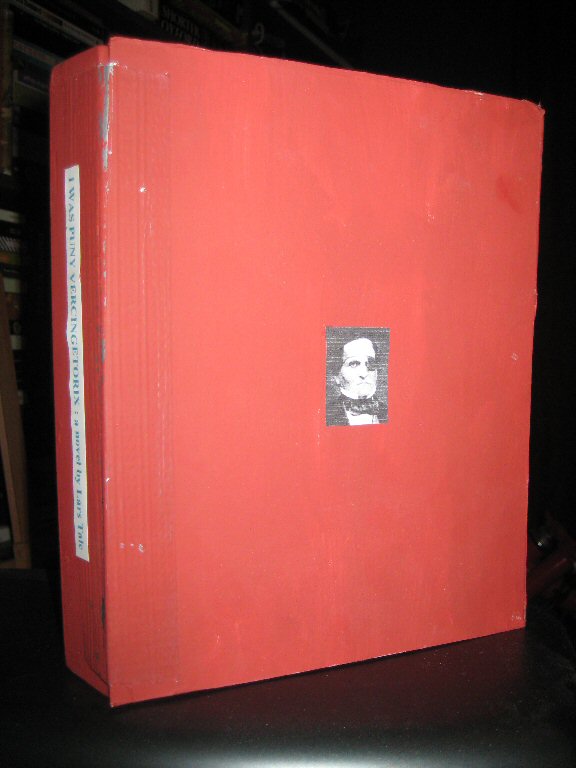It’s always an exciting moment when Dennis Beerpint publishes a new opus. The poet of the beatnik and the twee has a new book out next week, and what a very fat book it is! Those of you expecting a magisterial collection of epic Beerpintian versifying are likely to be disappointed, however. There is but a single poem nestled within its six hundred pages, and it is a very short poem. One might even call it gnomic. The rest of the book is given over to what Beerpint’s long-suffering publishers dub “hefty apparatus”. This sounds like something you might find in a well-appointed gymnasium, but is in fact a collection of what we literary types prefer to call “weird hot-headed ravings from Dennis Beerpint”.
There is an “introductory essay”, of over two hundred pages, which is neither introductory of anything nor, really, an essay as such. If one were to be kind, one might say it was an example of surrealist “automatic writing”. If one were to be unkind, but honest, one would say it resembles the disjointed drivellings of an untethered brain gone to seed. This farrago of nonsense is accompanied by so many footnotes that, taken together, they are longer than the “essay” itself. If we are to believe the preface (forty-nine pages in total), the footnotes were penned not by the poet, but by his all-too-real Doppelgänger, a sort of shadow Beerpint who dogs his every step, like the familiar in the story by J Sheridan Le Fanu.
Now listen. I have been following Dennis Beerpint’s career from its foetal stages, and this is the first I have heard tell of a Doppelgänger. I am assuming the poet is not referring to one of those fanatical acolytes who express their devotion by dressing like him, adopting the same hairstyles, eating and drinking an identical diet, and languishing upon municipal park benches clutching one of his flimsy poetry pamphlets to their bosoms, pretending to be morbidly ill. It pains me to say it, but I used to be one of their number. My bench was situated near the duckpond in the park, and I feigned tuberculosis. The point is that we were akin to the bodyguards employed by the film director George Lucas, who all look alarmingly like him, but we never pretended to be him, and we would certainly never have threatened Beerpint’s immortal, and poetic, soul. Yet these are the charges laid at the Doppelgänger’s door in the preface, and, indeed, by its own admission, in those interminable and frankly ill-written footnotes.
I have actually read the footnotes, in my review copy, with the aid of a magnifying glass. They are printed in very, very tiny type, in a font called Uber-Ornate Near-Illegible High German Blunkett Gothic. I have needed daily eye-drops ever since, and spend much of my time lying down in a darkened room. All I am willing to say is that the footnotes, far from casting any light on the imbecilic ravings of Beerpint’s essay, are themselves bereft of any sense whatsoever. It is like reading the prose of the more impenetrable Gallic postmodernists while being repeatedly beaten about the ears with a farmer’s shovel – an experience, by the way, I have undergone on more than one occasion, after accepting an offer to write a critique of Lacan or Derrida or one of those old frauds for the weekly magazine Farmers With Shovels Consider The Left Bank Intellectual Ferment. Despite my suffering, I recommend this publication, a sort of Reader’s Digest for the shovelling farmers community, and one which contains in each issue a goodly number of illustrations by the noted hyperrealist linocutter Rex Hyper.
But we are getting away from Beerpint, which will never do. In addition to the preface and the introductory essay with its voluminous footnotes, there is a lengthy section entitled “Mental Pudding”. I have read this half a dozen times and still have no idea what it is meant to be about, or what connection it has to the poem. Then there is a bibliography, supposedly of books consulted by the poet during the writing of his new work. This actually has some interest, giving us a valuable insight into Beerpint’s preoccupations and influences. He has read widely, if haphazardly, in almost as many languages as Anthony Burgess could babble in. No doubt the preposterous Mancunian polymath will be rolling in his grave that not a single one of his works appears in this bibliography. But Ayn Rand is there (Why I Like Stamp Collecting), and Pebblehead, and Robert Ludlum, and Dick Van Dyke (Faith, Hope and Hilarity: A Child’s Eye View of Religion). Beerpint seems also to know his onions when it comes to books about onions, birdseed, the Boxer Rising, lobsters, Futurist boy scouts, dirigibles and hot air balloons, fish entrails, Ruby and Oswald, the Scharnhorst, inexplicable flapping noises, the life and death of Karen Carpenter, bobsleigh, flumes, pigeons, gutta percha, tectonic plates, anteaters, William Betty “the Young Roscius”, tarpaulin, the Symmesian Hollow Earth Theory, gloves, infections of the pituitary gland, Bird’s custard – but, oddly, no other custard – , greenfly, hobnails, spiders, vinegar, Chumpot patent soap, the 1648 Peace of Westphalia, various paps and slops and gruels, gaslight, heists, H L Mencken, fruit, pips, sledgehammer wit, the Cottingley Fairies, other fairies, non-fairy life-forms, Geoff Hurst, Belshazzar’s Feast, oil rigs, Shoeburyness, herons, space travel, chrestomathies, car jacking, toilet tissue, bales of hay, bales of straw, bales, bales, Baxter’s Invigorating Fluid, and other bales.
It is important to acknowledge the breadth of knowledge Beerpint is bringing to the table, as it were, when one reads the poem. In the past, he has been accused – not least by me – of treating his readers with contempt and knocking out verses willy nilly, without care or thought, or even a proper pencil. I was particularly harsh in my review of his collection The Assassination Of Andrew Motion, which I described as “vindictive, contemptuous, and written without care or thought or even a proper pencil”. Beerpint has not spoken to me since, but I retain my superbly aloof critical detachment, and can therefore, with a foppish wave of my hand, announce, with due objectivity, that in spite of the ridiculous “apparatus” with which this new book is padded out, the poem itself is a masterpiece. Indeed, I would go so far as to say that it guarantees his place in the pantheon, for all time. I am so damned impressed with it that I am going to thumb my nose at the copyright laws and publish the poem here. That will save you from having to buy the book, and if as a result Beerpint or his publishers get upset then I am perfectly willing to meet them in a field, at dawn, with pistols.
So here it is then, the new poem from Dennis Beerpint, in its entirety:
Where oh where
Is the troglodyte Voltaire?







